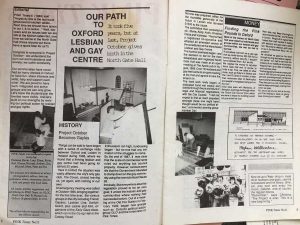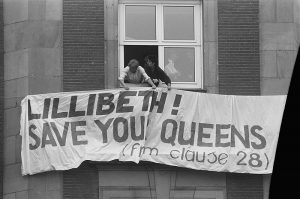Pink Times – A response to Section 28
 11 min read
11 min readIntroduction
November 2023 marked twenty years since the repeal of Section 28. Introduced in 1988, Section 28 was a piece of legislation prohibiting the discussion of homosexuality within schools. Specifically, it forbade the ‘promotion’ of homosexuality, emphasising that no school maintained by the Local Authority could ‘teach the acceptability of homosexuality as a pretended family relationships’ . The legislation was wildly controversial, particularly due to the ongoing AIDS epidemic; whilst the legislation did not forbid sexual health education, many foresaw that the hostile educational environment being cultivated would not be conducive to effective HIV/AIDS education. As a result, many LGBTQ+ groups came together to stand up to this legislation, through the creation of community groups, protests, and publications. In Oxfordshire, this manifested in the creation of Gay and Lesbian Oxford Rights Campaign (GLO), and its publication, Pink Times. The group launched Pink Times to be ‘not just a newsletter, but an independent lesbian and gay newspaper for Oxfordshire ’.
Section 28’s legislative significance lies in the culture of silence and fear created for LGBTQ+ teachers, and the marked absence of positive education role models and discussions for queer youth. Though there were no cases of legal prosecution under the section, the metaphorical significance had an undoubtable effect on those working in the education sector – encouraging self-censorship and a sense of fear about what could or could not be brought into the workplace. However, its significance outside of its official legislative domain is also notable: bringing communities together in opposition to the section. Thus, this blog post examines some of the significant impacts of Section 28, as told through Pink Times.
The Inception of Pink Times

A copy of the Pink Times from the archives of Tales of Our City, a community heritage project which preserves Oxford’s LGBTIQA+ history
Oxford has an interesting history with Section 28. Though Section 28 marked a return to regressive legislation, it nonetheless had the effect of invigorating the community – bringing together different groups within the community to unite against the government’s oppressive legislation. This blog post takes a dive into some of the developments that emerged in Oxford, as reflected and recounted within the pages Pink Times.
Pink Times initially ran from 1988 to 1991, releasing issues (more or less) quarterly in this time. As such, it was in production whilst Section 28 was at its height of relevance, in the years immediately following its passage into law. Thus, though the paper had a relatively short run, its pages hold a varied insight into Section 28 in Oxfordshire, outside of the perspective of legislative bodies or educational institutions. Indeed, the snippets discussed shed insight into a broad range of affected areas, including community development, wider council funding, transnational links, and reinvigorated activism.
Community and Collaboration
Section 28 was undoubtedly a catalyst for change within the community – perhaps an unexpected yet positive outcome of the legislation. As mentioned, Pink Times cites Section 28 as one of the main motivating factors in the paper’s creation. However, the changes within Oxford’s community do not stop here. In Issue 7 , in light of Section 28’s impacts on young people having access to positive role models, Pink Times announces the creation of ‘Young Friend’, set up by the lesbian and gay helpline Oxford Friend to respond to the needs of young people. Despite the circumstances encouraging its establishment, it is community groups like these that mark a positive change in the local landscape, establishing greater connections between different age groups and identities, certainly encouraging greater solidarity at a time when government legislation aimed to create an environment hostile to the LGBTQ+ community.
Alongside community collaboration in the face of Section 28, an ongoing theme throughout Pink Times is Project October, the project for the creation of a lesbian and gay centre in Oxford. Pink Times traces the development of this project, from its inception, to fundraising and campaigning, to securing a location, to its eventual opening. Interestingly, much of the coverage of Project October hints that their journey was made more difficult by Section 28. Indeed, although Section 28 should not have impacted community projects such as this, Issue 6 explains that the project would have to be ‘self funding’, ‘thanks to Section 28’. It seems as though the climate around Section 28 made it more difficult for councils to explicitly support local LGBTQ+ projects, as the difficulty in securing funding ‘thanks to Section 28’ implies that its legislative impacts went beyond its specified parameters.

Sir Ian Murray McKellen, CH, CBE at Manchester Pride 2010 image courtesy of Russ George
Pink Times also sheds insight into the wider community change, demonstrating the links beyond Oxford. In Spring 1991, Issue 9 excitingly featured an interview between Pink Times and Sir Ian McKellen. The significance of the paper is evident through this interview – not only is Pink Times being sold all over the country at this point, but they are also beginning to score interviews with big names such as McKellen. In the profile, McKellen talks about Section 28 being an influential catalyst in his coming out, as he wanted to be able to have a big part in the arts lobby against the legislation whilst also being able to explain why he had a personal interest in it. Thus, Pink Times not only recounts the impacts of Section 28 locally, but also brings these developments into a wider national context – this interview with Ian McKellen reinforced the importance of standing up against Section 28 at all levels.
Links to Education and Council Funding
The intended target of the legislation was Local Authorities and the schools under their jurisdiction. Indeed, despite its community-centred focus, Pink Times gives us a unique insight into how the legislation actually functioned at the council level, both in terms of education legislation but also in terms of granting council funding to LGBTQ+ projects outside of education.
The first two issues of Pink Times shed interesting light onto how the Oxfordshire County Education chief Tim Brighouse sent out a memo to heads of schools, community workers, and staff at colleges of further education informing them to disregard the recommendations of the legislation. Issue 1 of Pink Times contains a short article briefly noting that the memo informed teachers that the law does not ‘prevent the council nor its staff from offering the full range of services to homosexuals’, thus focusing more on who is engaging with council services, with less clarity on what services can and cannot offer. However, the details on this are shared in the following issue, where Brighouse’s extended quote is featured – widening the information shared through the newspaper to clarify what the ‘full range of services’ could include.
Issue 2 thus expands on this coverage, with information shared by councillor Margaret Godden. It is this issue that names Brighouse as the Oxfordshire County Education chief, as well as highlighting the expanded quote of what is covered within the ‘services’. Brighouse indicates that it includes ‘counselling, the use of books and periodicals including those about homosexuality and/or written by homosexuals, arts and theatre events which may or may not include homosexual themes’ and the ‘objective discussion of homosexuality in the classroom’. The explicit citation of ‘books and periodicals’ is notable, as it was the inclusion of the children’s book ‘Jenny Lives with Eric and Martin’ in the library of a school in a Labour-controlled local authority that became the galvanising topic around which the Conservative government pushed for Section 28, arguing that it was the inclusion of books such as these that were ‘promoting homosexuality’ in schools. It is interesting, therefore, that the Oxfordshire County Education chief would so explicitly defy the legislation in his memo – a strong message being sent to local schools as his final message in his post.
Moreover, the first few issues mention Oxford’s AIDS Liaison Officer, previously Carl Miller, as they advertise the job opening. This role is particularly interesting in the context of Section 28. The AIDS Liaison Officer was employed by Oxford City Council, with a key element of the job being ‘drama in schools, an extensive programme of training for professionals and community education’, as shared in Issue 2 . It is striking that so soon after Section 28’s passage into law, when it was still unclear how the legislation would function in practice, this job opening would entail council-sanctioned, schools-based AIDS education. This, in combination with Brighouse’s memo, paints an interesting picture of how Section 28 functioned in Oxfordshire, and the ways in which it was resisted even at an official, council-based level.
Links with Leiden

Demonstrators in the Netherlands protest Section 28 during a state visit by Elizabeth II to the country, 1988. (Wikipedia images)
Oxford’s links with Leiden in the Netherlands extend beyond being twin cities. Pink Times documents extensive connections between Oxford and Leiden’s gay and lesbian communities. This was partially a social link, with visits to both cities recorded frequently through the eleven issues of Pink Times. However, Issue 2 of Pink Times details that the community’s friends in Leiden were also vocal against Section 28. The issue reports that on one of their visits to Oxford, the Leiden group met with the Lord Mayor, who subsequently answered questions from the group. Amongst these questions were ones asking about the Lord Mayor’s stance on gay policy and Section 28. Clearly, the significance of Section 28 was even evident to those overseas with links to the British LGBTQ+ community – enough for the visitors from Leiden to feel compelled to ask the Lord Mayor about it.
Activism
Not only was there increased solidarity and collaboration between Oxford’s gay and lesbian community, there was also greater overlap between the students and residents. Pink Times records how local students came out in support of the local community’s efforts against Section 28. Indeed, Issue 4 ’s ‘News in Brief’ section reported that Oxford University’s Gaysoc ‘had not forgotten about Section 28’, with over 100 students marching through the city on its anniversary. The issue uses this news item to reassert the importance of continued protest against Section 28, urging readers to not give up on protest ‘until Section 28 is scrapped’.
Likewise, Pink Times also recounts cross-community collaboration, detailing the ways in which the lesbian and gay Quakers, officially the Friends Homosexual Fellowship (established 1973) spoke out against Section 28. Issue 10 notes that the group were incredibly active in speaking out for community issues, including fundraising money for AIDS community groups, and actively opposing Section 28. It notes that the group was also able to gather support from straight Quakers, who joined them in writing to the Home Office in protest. It is evident through the various niche groups highlighted in Pink Times that Section 28 had a striking impact on activism within the community, particularly the strengthened collaboration between different groups.
Conclusion
From overseas links to connections with Ian McKellen, Section 28 was counter-intuitively a catalyst for positive community change in Oxford. As Lis states in Issue 10, the legislation and the AIDS crisis ‘between them were responsible for bringing lesbians and gay men together in mixed groups’. Thus, the local effects of Section 28 extended beyond the realm of education, becoming intertwined with community organisation, activism, and cross-national connections. Pink Times presents a great illustration of Oxford’s experiences with Section 28, from the perspective of a community group established in opposition to the legislation.
If you are interested in reading some excerpts from Pink Times, please visit the Oxford City Stories page! Moreover, if you have any memories of Section 28 in Oxfordshire, we would love to hear from you – please consider sharing your story by following this link to share your story with us!
Cover of Pink Times issue 1, Autumn 1988 · Museum of Oxford – City Stories (omeka.net)
Section 28 in Oxfordshire · Museum of Oxford – City Stories (omeka.net)
www.legislation.gov.uk/ukpga/1988/9/section/28/enacted
Written and researched by MOX volunteer Samantha Hicks.
Want to write your own Oxford-inspired post? Sign up as a volunteer blogger.
Copyright
© Oxford University
